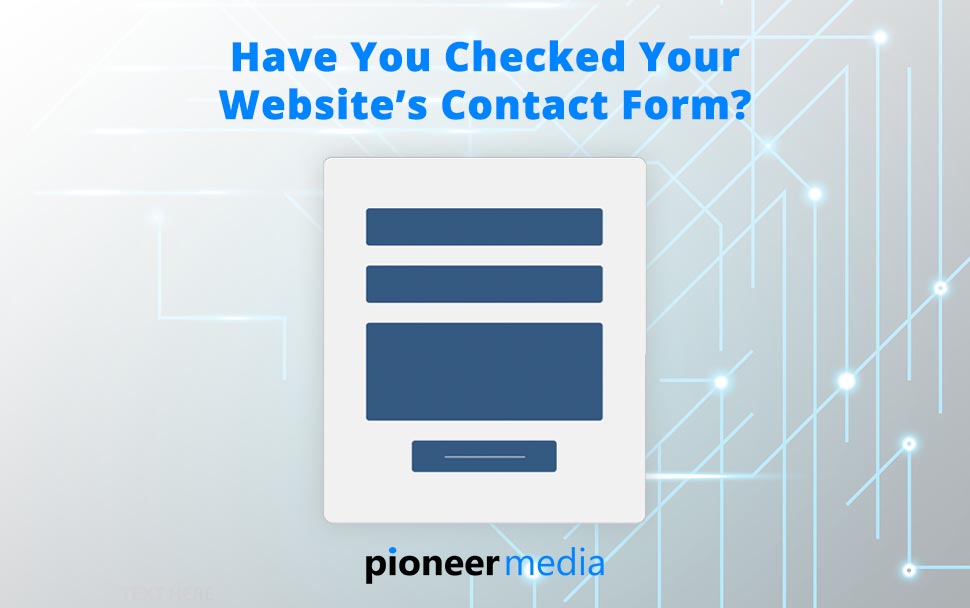Check Your Website’s Contact Form

Your website’s contact form is one of the easiest and most effective ways for potential customers to reach you.
The simplest forms have fields for the person’s name, email address and message.
They could be filling out the form for a number of reasons, such as:
- To offer feedback
- To ask you a question
- To solicit their business
- To request a free estimate
- To send you a direct message
Whatever the reason, it is imperative you receive these messages. When the visitor clicks the Submit button, the results should be emailed to an appropriate person at the company. These submissions can be responded to directly by replying to the email.
What steps are taken to improve form submission deliverability?
There are several steps we take to create and maintain a working online form:
- Create your form using industry-leading form software, such as Gravity Forms, which is backed by a support team of developers.
- Secure your entire website using Cloudflare’s CDN and firewall protection.
- Secure your contact form using Google reCAPTCHA, the most popular fraud and abuse protection for online forms (you may recognize this as the “I’m not a robot” checkbox).
- Integrate an email deliverability service, which is specifically designed to get emails from your website to your inbox.
- Keep your website’s software (such as WordPress) up to date as part of our Website Care Service.
Any one of these technologies could experience a temporary glitch and need attention (did anyone say technology is perfect?). That leads us to your next question:
Why do some contact form submissions not land in my inbox?
Some legitimate contact form submission emails will incorrectly be flagged as SPAM. In this case, you should check your Spam folder and mark these as NOT SPAM/JUNK to train your mail client.
Others will correctly be flagged as SPAM, since contact forms are huge targets for mass spamming. Forms hosted by Pioneer Media are setup with industry-leading spam protection software, such as Google’s reCAPTCHA (you may recognize this as the “I’m not a robot” checkbox). These techniques cut down on form submission spam, but it’s nearly impossible to eliminate spam. Remember, just as these spam protection companies mature, so do the developers behind the spam bots!
Occasionally, the email deliverability software will incorrectly flag your recipient mailbox as “Stale” or “Complaint,” meaning the software has detected enough spam or non-opens to unsubscribe your inbox completely. This is done with the best intentions, but if your legitimate form submissions are included, we need to manually resubscribe you.
To ensure form deliverability, we highly recommend these 2 best practices:
- Check your SPAM/JUNK folder every few days for false-positives. This just takes a few seconds and could save you from missing out on an important transaction initiated by your site’s contact form.
- Routinely test your website’s contact form. When your website was built, the form was setup to send submissions to your email address. Maybe the address has changed? Maybe you would rather the submissions go somewhere else now? Maybe the form’s deliverability software has unsubscribed your recipient address due to spam? Whatever the reason, you should test your contact form regularly (at least monthly) to make sure you are still receiving your form submissions. As your webmaster, I cannot check this for you because I do not have access to your inbox to see if the submission was delivered.
Follow these best practices to ensure customers and potential clients can easily reach you using whichever communication method they prefer.
About the Author
My name is Leighton Smith, an enthusiastic resident of East Tennessee. In business, I wear several metaphorical “hats.” I am Pioneer Media’s website designer, web developer and webmaster. Each is a unique role in the process of creating a website. As a “solopreneur” freelancer, I am self-employed and your one-and-only point-of-contact for your website. I’ve built 100s of websites since learning to code in 2006 and absolutely love what I do. In addition to helping small businesses, I enjoy volunteering, strengthening relationships and traveling the world. Let’s discuss your project to see if we’re a good fit!

